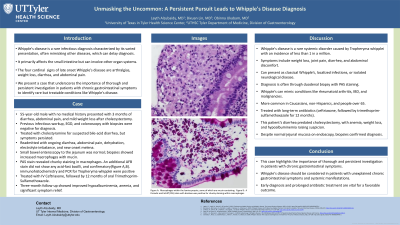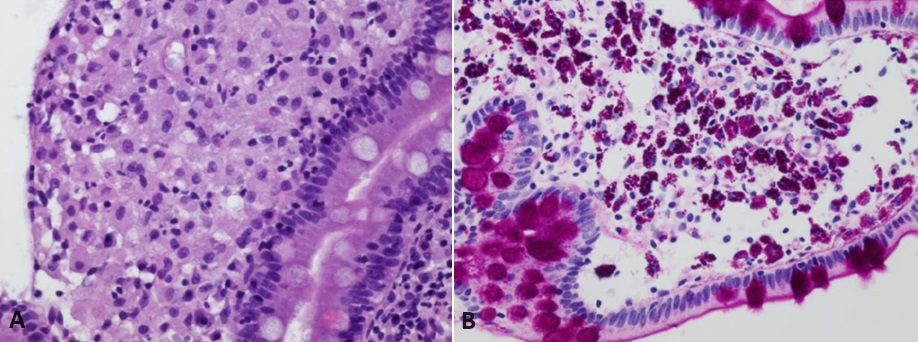Sunday Poster Session
Category: Small Intestine
P1548 - Unmasking the Uncommon: A Persistent Pursuit Leads to Whipple's Disease Diagnosis
Sunday, October 27, 2024
3:30 PM - 7:00 PM ET
Location: Exhibit Hall E

Has Audio

Layth Alzubaidy, MD
University of Texas Health Science Center
Tyler, TX
Presenting Author(s)
Layth Alzubaidy, MD1, Bixuan Lin, MD1, Obinna Ukabam, MD2
1University of Texas Health Science Center, Tyler, TX; 2Texas Institute of Gastroenterology Associates, San Antonio, TX
Introduction: Whipple's disease is a rare infectious diagnosis characterized by its varied presentation, often mimicking other diseases, which can delay diagnosis.
Case Description/Methods: We present a case of a 55-year-old Caucasian male with no prior medical history who presented to the emergency department with a 3-month history of diarrhea, abdominal pain, and mild weight loss following an elective cholecystectomy. He had a similar presentation one month earlier, where an infectious workup was unremarkable, leading to outpatient esophagogastroduodenoscopy (EGD) and colonoscopy, that did not establish a diagnosis for his symptoms despite biopsies. He was subsequently treated with cholestyramine for suspected bile-acid diarrhea which did not improve his symptoms. He was admitted again with persistent diarrhea, abdominal pain, dehydration, electrolyte imbalances, and new onset melena. A small bowel enteroscopy was performed and advanced to the proximal to mid jejunum, which appeared normal, and biopsies were obtained. Microscopic examination showed an increase in macrophages within the lamina propria, some of which were mucin-containing (figure A). A Periodic acid-Schiff (PAS) stain with diastase was positive for chunky staining within macrophages (figure B). An additional AFB stain did not show any acid-fast bacilli, and confirmatory immunohistochemistry and PCR for Tropheryma whipplei were positive. Given the histological findings and clinical presentation, a diagnosis of Whipple’s disease was established. The patient was treated with IV Ceftriaxone followed by oral Trimethoprim-Sulfamethoxazole for 12 months. At a three-month follow-up, the patient’s hypoalbuminemia and anemia had improved, and he reported significant relief of symptoms, including diarrhea and abdominal pain.
Discussion: This case highlights the importance of thorough and persistent investigation in patients with chronic gastrointestinal symptoms. Whipple's disease should be considered in patients with unexplained chronic gastrointestinal symptoms and systemic manifestations. Early diagnosis and prolonged antibiotic treatment are vital for a favorable outcome.

Disclosures:
Layth Alzubaidy, MD1, Bixuan Lin, MD1, Obinna Ukabam, MD2. P1548 - Unmasking the Uncommon: A Persistent Pursuit Leads to Whipple's Disease Diagnosis, ACG 2024 Annual Scientific Meeting Abstracts. Philadelphia, PA: American College of Gastroenterology.
1University of Texas Health Science Center, Tyler, TX; 2Texas Institute of Gastroenterology Associates, San Antonio, TX
Introduction: Whipple's disease is a rare infectious diagnosis characterized by its varied presentation, often mimicking other diseases, which can delay diagnosis.
Case Description/Methods: We present a case of a 55-year-old Caucasian male with no prior medical history who presented to the emergency department with a 3-month history of diarrhea, abdominal pain, and mild weight loss following an elective cholecystectomy. He had a similar presentation one month earlier, where an infectious workup was unremarkable, leading to outpatient esophagogastroduodenoscopy (EGD) and colonoscopy, that did not establish a diagnosis for his symptoms despite biopsies. He was subsequently treated with cholestyramine for suspected bile-acid diarrhea which did not improve his symptoms. He was admitted again with persistent diarrhea, abdominal pain, dehydration, electrolyte imbalances, and new onset melena. A small bowel enteroscopy was performed and advanced to the proximal to mid jejunum, which appeared normal, and biopsies were obtained. Microscopic examination showed an increase in macrophages within the lamina propria, some of which were mucin-containing (figure A). A Periodic acid-Schiff (PAS) stain with diastase was positive for chunky staining within macrophages (figure B). An additional AFB stain did not show any acid-fast bacilli, and confirmatory immunohistochemistry and PCR for Tropheryma whipplei were positive. Given the histological findings and clinical presentation, a diagnosis of Whipple’s disease was established. The patient was treated with IV Ceftriaxone followed by oral Trimethoprim-Sulfamethoxazole for 12 months. At a three-month follow-up, the patient’s hypoalbuminemia and anemia had improved, and he reported significant relief of symptoms, including diarrhea and abdominal pain.
Discussion: This case highlights the importance of thorough and persistent investigation in patients with chronic gastrointestinal symptoms. Whipple's disease should be considered in patients with unexplained chronic gastrointestinal symptoms and systemic manifestations. Early diagnosis and prolonged antibiotic treatment are vital for a favorable outcome.

Figure: Figure A: Macrophages within the lamina propria, some of which are mucin-containing. Figure B: A Periodic acid-Schiff (PAS) stain with diastase was positive for chunky staining within macrophages.
Disclosures:
Layth Alzubaidy indicated no relevant financial relationships.
Bixuan Lin indicated no relevant financial relationships.
Obinna Ukabam indicated no relevant financial relationships.
Layth Alzubaidy, MD1, Bixuan Lin, MD1, Obinna Ukabam, MD2. P1548 - Unmasking the Uncommon: A Persistent Pursuit Leads to Whipple's Disease Diagnosis, ACG 2024 Annual Scientific Meeting Abstracts. Philadelphia, PA: American College of Gastroenterology.
